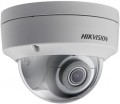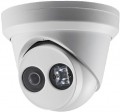— PTZ (controlled). PTZ is an abbreviation for camera control capabilities - “pan, tilt, zoom”. Accordingly, cameras with this feature are equipped with a movable lens that allows you to aim at the desired object; but the magnification can be either optical (see below) or digital. The advantages of
PTZ cameras are obvious: their view is not limited to one position, it can be adjusted at the operator’s request. And some models may provide advanced functions, such as automatic targeting and focusing on movement. On the other hand, similar systems cost accordingly.
- Private mode. A feature that allows you to temporarily pause the camera to protect the privacy of people in its field of view. In private mode, the camera temporarily stops recording video, broadcasting images, and performing other actions related to video surveillance. It is important to note that the implementation of private zones or temporary disabling of recording is available in almost any video surveillance camera. In this case, we are not talking about software capabilities, but about creating conditions in which the camera cannot physically record. So, some models hide the lens inside the body, others turn their “look” away in a predetermined direction (for example, to the corner of a wall). Private mode can be activated forcibly (by pressing a button on the camera body or in a mobile application) or according to a preset schedule.
—
PoE power supply. Power technology used in cameras with wired LAN connections. The PoE function allows you to supply power to such a camera through the same cable that is used to transmit the signal - this eliminates the need to run an additional wire to the outlet or use batteries/rechargeable batteries. Of course, to use this technology, the connector of the recorder (or other device) to which the camera is connected must also support it. But it’s worth considering that there are different PoE standards, which primarily differ in power (802.3af power up to 13 W, PoE 802.3at - 25.5 W).
—
PoC power supply. An analogue of PoE technology used in traditional cameras: it allows you to supply power through the same cable that is used for the video signal, and thus do without connecting to an outlet and without batteries/batteries. The difference is that PoC operates over a coaxial cable with a BNC connector. Of course, to use this function it must be provided both in the camera itself and in the recorder.
—
Panoramic shooting. This feature means that the camera has multiple lenses and covers a horizontal angle of at least 180°, providing a wide field of view when the body is stationary. Such a field of view can be achieved with one fisheye lens (see the corresponding paragraph); however, panoramic shooting has one important advantage: the level of distortion in such video is much lower, even at the edges. On the other hand, the presence of several “eyes” has a corresponding impact on the price and dimensions.
—
Setting up a region of interest (ROI). This function allows you to define individual zones in the camera's field of view. Note that the tasks of the selected areas may be different. One option is to configure motion detection zones in the frame, which can reduce the level of false alarms. The second possible implementation is to reduce the quality of less important areas of the image to save storage space. The latter can be especially useful when there is a shortage of data storage capacity, and also if the camera uses communication channels with limited speed or traffic volumes (for example, a 3G/LTE mobile network). Either way, the Region of Interest (ROI) feature reduces camera strain and lets you focus on what's important to you first.
-
Light sensor. The presence of a light sensor in the camera design. As a rule, this sensor is used to determine the characteristics of the surrounding environment and automatically adjust to its characteristics - in particular, switching between day and night modes, turning on IR illumination (see below), etc.
—
Motion detection. Cameras with this feature are able to detect movement in the field of view. This function is convenient because the vast majority of situations that need to be recorded during video surveillance are associated with movement in the frame. The specific reaction to movement may be different: in some models, recording is turned on, others also send a notification to the recorder or other device, others are able to turn after a moving object, etc. Cameras with this function are especially convenient for monitoring objects where movement is rare - for example, warehouses or underground parking lots at night: for example, turning on motion-based recording only saves storage space and makes it easier to view footage.
—
Sound detection. Function for detecting sounds in a protected area. Having “heard” a sufficiently loud sound, a camera with this function can react in one way or another: start recording, sound a warning or alarm, etc. Some models can even play the role of acoustic break sensors, accurately detecting a characteristic impact on the glass and the sound of shrapnel. Support for audio detection automatically means the presence of a microphone (see the corresponding paragraph).
—
Microphone. The presence of a microphone in the camera design allows it to record not only the image, but also the sound. This allows you to get a more complete picture of what is happening when recording. In addition, a microphone can be useful if the person in front of the camera wants to communicate something to the operator, and if there is a feedback speaker (see below), even a full dialogue is possible.
—
Feedback speaker. The camera has its own built-in speaker. One of the most popular uses of this feature is indicated in the name - it is the operator’s feedback from people near the camera. Thanks to the speaker, you can, for example, voice directly through the camera a hint for a lost visitor, a warning or order for an intruder, etc. In addition, this function can be used for other purposes - in particular, to generate an alarm.
-
Mobile app. The ability to work with the camera through an application installed on a gadget such as a smartphone or tablet. As a rule, this control method gives access to both broadcasting/saving video and most settings; but the specifics of the communication between the gadget and the camera may be different. Thus, modern applications often provide for the possibility of remote access via the Internet from anywhere in the world; however, there is another option - a direct communication (usually via Wi-Fi), which only works in the immediate vicinity of the camera. These nuances should be clarified separately. Be that as it may, the mobile application is convenient in that it can be installed on almost any modern smartphone or tablet running Android or iOS, turning the gadget into a portable camera control station.
—
Motion alert. A function found in cameras with motion detectors (see above). When motion is detected in the frame, such models are capable of not only taking their own actions (for example, turning on recording), but also sending notifications to the user in one way or another. Specific methods for transmitting alerts may be different - email, SMS, notification on a special web page, etc. But in any case, this function makes it easier to track the observed object and reduces the risk of missing an important event in the frame.
—
Alarm input/output. As a rule, cameras with this function are equipped with both inputs and outputs; the number of both may be more than one. These connectors are used to transmit control signals to various components of the security system; they allow you to build a very advanced system and provide additional capabilities for managing its functions. Thus, alarm inputs allow the camera to “react” to commands from other elements - for example, turn on when an electronic lock on the door is triggered. And the outputs, accordingly, are used to transmit commands to external devices - for example, to turn on the spotlight when motion is detected in the frame.
—
Audio input/output. The presence of audio input and/or output in the camera design. This feature makes it possible to work with sound, but the features of this work may vary, depending on the specific set of connectors. The audio input itself makes it possible to connect an external microphone, and the audio output allows you to output sound to an external device (for example, a recorder or an amplifier with speakers) via a separate channel. At the same time, these connectors can be used one at a time. For example, a camera with a built-in microphone may only have an audio output, but a model with a LAN or Wi-Fi communication is capable of transmitting an audio signal through the same channel, and for such cameras an audio input is sufficient.
— IR illumination. The presence of an infrared illumination system in the camera design. This illumination is used for operation in night mode: IR illumination is invisible to the naked eye (you can only notice a faint reddish glow of the backlight LEDs, and even then not always), but is well perceived by the matrices of modern surveillance cameras. The ability to do without visible light sources is convenient for a number of reasons: in particular, such work hardly reveals the camera.
—
LED backlight. The camera has an LED backlight. Like the infrared illumination described above, this backlight is designed to work in the dark; however, it provides light that is visible to the human eye, allowing the camera to produce a relatively natural-looking color image.
-
Card reader. A device for reading removable memory cards, usually standard SD or microSD (specific types of supported cards should be clarified separately). This device performs two main functions. Firstly, it allows you to equip the camera with its own drive - this provides an additional guarantee in case of failures in the external recorder and even allows you to record without any additional equipment at all. Secondly, memory cards allow you to conveniently exchange data with laptops, PCs and other external devices - first of all, transfer footage onto them.
Ruggedized housing providing enhanced protection against damage attempts.
The specific degree of strength may vary. For example, many manufacturers use the IK standard for impact resistance. The highest rating in this standard is IK10, providing protection against impact with an energy of up to 20 J, which corresponds to a 5 kg load falling from a height of 40 cm; more detailed information on IK can be found in special sources. At the same time, cameras that do not have IK certification can also be positioned as vandal-resistant.
Note that even the most
vandalism-resistant housing does not provide absolute protection against damage. However, this feature, anyway, significantly complicates the attacker's task and may even force him to give up trying to permanently spoil the camera. And the purposeful removal of the camera from the system turns out to be a rather difficult and long matter. And in some models, the increased strength of the case can be combined with other features — for example, a sensor that sends an alarm when attempts are made to damage the camera.

